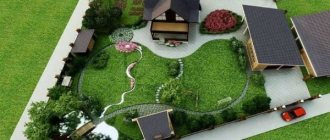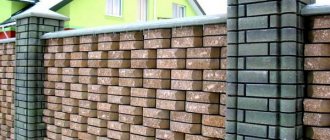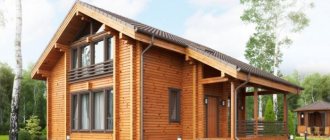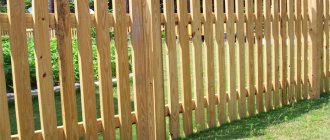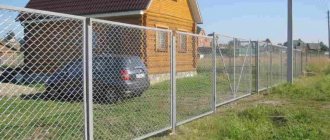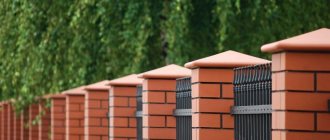When erecting a fence, the dacha owner pursues the following goals:
- designation of site boundaries;
- protection from noise and dust;
- an obstacle to unauthorized entry by strangers;
- ensuring the confidentiality of residents;
- decorative component of landscape design.
Often, the installation of a fence becomes a cause of conflict between neighbors.
To avoid claims, it is enough to comply with the requirements of building regulations regarding the installation of fences for a site located on the territory of SNT or individual housing construction. According to paragraph 6.2 of SNiP 30-02-97, which explains the rules for planning garden plots:
- fences between areas must be made of mesh or lattice, the permissible height is 1.5 m;
- fences on the side of driveways and streets can be built blank if this is authorized by a decision of the general meeting of summer residents (gardeners).
Why do you need a fence on your property?
The legislation of the Russian Federation allows owners of suburban areas to produce enclosing structures of any configuration. You can find transparent and opaque, wooden, stone, steel and other fences. Regardless of the materials, all fences have common tasks:
- Decorating the land plot if the fence has an aesthetic appearance.
- Masking the yard and the activities taking place on it from prying eyes.
- Preventing possible encroachments on property by neighbors.
- Protecting the area from dust and noise from the road, from strong winds and from debris.
- A guideline for maintaining the distances specified in building codes.
Due to their many advantages, fences are found in almost all suburban areas in Russia, regardless of the region. Only the appearance, dimensions and selected material change.
Decor
It is also necessary to draw up your development plan in compliance with all necessary requirements. First, the appropriate permits are collected and a project is developed, which is agreed upon by all necessary authorities. After construction, the competent services draw up an act of acceptance and commissioning of the facility, which must be registered with the BTI.
You can, of course, do things differently and try to agree on a plan with some shortcomings. But at any moment this could result in a series of lawsuits and worsening relations with fellow villagers. Your reputation will suffer, and corrective action will become more difficult over time.
Why you need to follow the rules
Maintaining the minimum permissible distance from the fence to buildings is required primarily for fire safety reasons. Imagine the situation - the building was built close to the fence, behind which the neighbor’s house is also close. In the event of a fire, the fire can easily spread from one house to another: this way, along the chain, an entire village can completely burn out.
The second reason to responsibly comply with the distance standards from the house to the fence is the risk of litigation with neighbors. For example, they may not like the shadow of your building falling on their property, or an agricultural building blocking their view. There are many reasons to bring a claim to court based on non-compliance with regulated construction standards.
Sets of rules have been created to regulate the construction of buildings and help avoid litigation. There are several of them, this is construction:
- within the city SP 30-102-99;
- dacha plots SNiP 30-02-97, current version SP 53.13330.2011;
- Federal Law 123-FZ on fire safety retreats.
You need to know that construction is prohibited on ONT sites, except for greenhouses and small outbuildings. The total area of buildings should not exceed 30% of the area of the garden plot (SNT).
What to do if a neighbor violates building rules?
Very often situations arise when neighbors build a shed, bathhouse or garage close to the adjacent fence. Such buildings block light, snow rolls off their roofs onto your side of the fence, and when it rains, water erodes the ground on your site. In this case, you need to try to resolve the issue peacefully - talk, explain how many meters from the fence you need to retreat, ask to eliminate the violations.
If you can’t reach an agreement, you can file a statement about violation of the rules with local authorities or file a statement of claim in court.
Many rules are not mandatory and are advisory in nature. Therefore, before rushing into battle and defending your rights, you need to thoroughly study the legislative framework or consult a lawyer. A specialist will help you understand the nuances of individual housing construction, give advice on how to correctly draw up an application, how to competently substantiate your complaint and support it with documents.
You need to be prepared for the fact that legal proceedings will require expenses and take a lot of time. In addition, the owner of the neighboring property may file a counterclaim in retaliation.
Distance to different buildings
So, there are no more questions regarding the importance of observing the recommended intervals between the fence and various buildings. Now it is important to find out what gaps must be maintained between the fence and residential or commercial buildings so as not to violate the laws of the Russian Federation.
Location of buildings on the site indicating distances to the fence
Interval to home
According to SNiP 30-02-97 (Building codes and regulations), the distance from the fence to the house must be at least 3 meters, provided that the fence is located on the border of the site. It is important to take into account the fact that in a residential property the reference point is the protruding part closest to the fence, if it protrudes more than 50 cm relative to the wall. Otherwise, the countdown is from the wall itself.
Often, homeowners ignore or are not aware of the rule by which the distance between the fence and the individual residential construction project (IHC) is calculated. Judicial practice knows of cases where trials were lost even because of a few centimeters, if the distance was measured from a wall or foundation, and there was a base protruding half a meter.
Interval to outbuildings
More stringent SNiP requirements apply to the distance between the fence of the site and agricultural buildings intended for keeping domestic animals and poultry. The minimum distance is 4 meters. These standards are dictated not only by SNiP, but also by sanitary and epidemiological rules and regulations (SanPiN). This is caused by the following factors:
- Risk of contamination and contamination of neighboring soil with waste from animals and birds.
- The appearance of agricultural buildings is often unaesthetic.
- An unpleasant smell that often comes from outbuildings with animals.
A distance of 4 meters between outbuildings and the fence must be maintained regardless of the site. You will have to comply with the standards, even if the house was built in a gardening association.
Distance to toilet
There are separate regulations in case it is planned to build a latrine or cesspool on the site. When choosing a location for arranging such facilities, you need to retreat at least 12 meters from residential buildings that are located both on the construction site and on neighboring areas adjacent to it. In this case, the minimum distance to the fence is 1 meter.
When installing cesspools, septic tanks and outdoor toilets, it is also important to maintain a distance of at least 8 meters in relation to sources of underground water. This applies to wells and boreholes. Failure to comply with these standards will most likely lead to water contamination. For similar reasons, there should be a minimum of 12 m between yard toilets and cellars.
Interval to other buildings
In addition to agricultural buildings, a suburban area may contain buildings such as a bathhouse, sauna, garage or other functional buildings. SP 53.13330.2011, requires maintaining a distance between functional buildings and the fence of at least 1 meter. However, there are some conventions:
- If there is 1 meter between the object and the fence, the roof slope should be directed towards the yard.
- The garage attached to the house should be located at a distance of 3 m from the fence.
When choosing a place to build showers, summer kitchens and other functional buildings, it is important to consider that the distance between them and residential buildings on the site should be 3 meters or more. The same applies to outbuildings for keeping animals and poultry.
An attached garage saves space, but you need to plan ahead
When constructing bathhouses and other fire-hazardous buildings, it is important to take into account some nuances. According to the standards, the distance between such buildings to the fence should exceed 3 meters, and to the building on the neighboring site - 8 meters. If the building is made of materials belonging to flammability class 1 or 2, the minimum distance to the neighboring house is reduced to 6 m.
Interval to greenhouse
The construction of greenhouses is popular among many summer residents, so the question of how far from the fence a greenhouse can be installed is very relevant. According to SP 42.13330.2011, a distance of at least 1 meter must be maintained from the fence on the border of neighboring plots to the greenhouse. The minimum distance to residential buildings (your own and neighbors) is 3 meters.
Correct location of the greenhouse
Requirements for gardening partnerships
The abbreviated name is SNT. Their development is regulated by SNiP 02.30.97. However, such non-profit organizations often have their own charter, approved by the competent services. In some cases, it is even possible to leave areas without a fence.
The height of the street fence in garden associations should not exceed 2.5 m. There are no restrictions on the materials.
The adjacent fence is made of translucent elements at a height of up to 2 m. Moving it unilaterally is prohibited.
If outbuildings on two plots are located quite close, then with the permission of the neighbors it is allowed to go slightly into the neighbor’s territory. However, this should not become the reason for blocking the passage for residents, the passage of transport, or blocking access to communications.
Since the fence is not installed for one year, any changes or agreements should be recorded in writing and notarized.
Distance to green spaces
Since the land plot can contain not only buildings, but also green spaces, there are regulations for this case too. Leaving a gap between the fence of the site and flower beds is not as important as between trees and bushes. Here, too, it is necessary to comply with the rules in order to avoid penalties and claims from neighbors with possible litigation.
Distance to trees
Tall trees growing close to the border of two plots of land are another subject of dispute between neighbors. To avoid legal disputes with residents of neighboring houses on this basis, maintain the recommended interval of 2 meters between medium-sized trees and the fence, and 4 meters if the trees are tall. The distance is calculated from the center of the trunk.
You need to maintain a distance not only from buildings, but also from trees to the fence
How to understand which trees grow on the site - medium-sized or tall? This is not stated in the laws, however, there is an unspoken rule - tall trees with a height of more than three meters. There are no restrictions or additions depending on the type of tree - apple trees, cherry plums, birches, tall pines, as well as wild or exotic trees can grow at the permitted distance.
Distance to bushes
The minimum gap between shrubs and the fence at the border of the site is 1 meter. The distance regarding flower beds and flower beds is not mentioned at all in the building rules and regulations. This means that you can plant flowers even close to the fence - this is legal. As with trees, there are no restrictions on the types of shrubs - the main thing is to keep your distance.
Types of fencing
A wide range of building materials allows you to install an inexpensive fence both from the street and to protect yourself from neighbors in order to hide from prying eyes.
Let's highlight the most popular and affordable types of fencing:
- Shield. It is assembled from wooden boards fastened to a frame made of timber. Has the shape of a rectangle. The standard length is 1.8 m. The material on the board is located horizontally or vertically. Sold ready-made. However, they should be treated with antiseptics and fire retardants. A popular species is pine.
- Trellis. Decorative, but not protective fencing. Wooden slats are connected to each other into squares. The trellis requires painting.
- Palisade Available for sale in rolls. Wooden stakes are installed close to each other. Can be reinforced with steel wire. The fence is quite strong, but not very attractive to look at.
- Rabitz. It is used as a fence when arranging a barn, a place for walking livestock, poultry in the village. It is not practical to use in the city, since the entire yard will be clearly visible.
- Fence. You can build such a fence low, up to 10 cm, as a fence for a flower bed, or high, to close the area from the street. Wooden planks are placed vertically and nailed to horizontally laid beams.
Fences made of corrugated sheets, metal with forged elements, brick, and stone will cost much more. Such a fence will be more reliable, durable and beautiful.
Barbed wire can be used as a material no lower than 2 m from the ground, so as not to cause injury to surrounding people.
If a fence is installed to separate two vegetable gardens, then its height and design should not block the flow of light or disrupt air exchange. Chain-link and picket fence are well suited for this.
It is worth highlighting situations when, before building a fence, owners need to obtain permits from the relevant services:
- the boundaries of the territory are not included in the cadastral plan;
- the land is located in the vicinity of architectural monuments and industrial facilities;
- The building area is quite small and because of this it is not possible to adhere to GOST standards.
In the latter case, BTI employees who understand all issues related to home ownership can help.
Distance to the red line
The red line is the actual border between land plots. It is this border that has great legal weight, as it is documented in official cadastral registration documents. Residential buildings and functional buildings on the site must be located at least 5 meters from the red line of the street, and at least 3 meters from the red line of the road.
It is very important to maintain the distance from home to the red line
The fence is usually installed along the border of the property along the red line. If the fence has a wicket or gate, then it should open into the yard so as not to cover the red line. For the same reason, the construction of garages on the same line with the fence, standing close to the red line, is not allowed. Failure to comply with the interval may lead to demolition.
Do you need to follow the rules?
The norms of SP, SNiP and SanPiN were not invented so as to ensure that they are observed. For neglect of instructions, administrative liability is provided, which is regulated by Art. 9.4 of the Administrative Code of the Russian Federation. The first time the offender will receive a verbal warning. If it is not eliminated, a fine of 1 to 2 thousand rubles will be issued.
More serious sanctions will follow if it is proven that disregard for the rules has caused harm to nature or neighbors. The first time the offender faces a doubled fine, that is, from 2 to 4 thousand rubles. Repeated violation is punishable by an even larger fine of up to 5 thousand rubles. Litigation over non-compliance with the distance to the fence is not uncommon.
It is noteworthy that establishing the fact of non-compliance with the minimum distance between a house, building or tree and a fence is not yet a reason to force the violator to solve the problem. Demolition, relocation of a building or removal of green spaces can only be achieved through the courts. However, the best option is to maintain a distance from the house to the fence and avoid conflicts.
Regulatory acts and documents
According to the legislation of the Russian Federation, construction on a land plot is permitted only if there is a Certificate of Ownership.
Verify all the data in the permit document and use the land in accordance with its intended purpose.
The construction of a private building is permitted only for:
- agricultural lands, with permission for dacha construction (in the future and for gardening);
- lands of settlements, for individual housing construction or for personal subsidiary plots;
- lands for complex housing construction.
After thoroughly checking the compliance of documents, it is necessary to begin planning in accordance with legislative acts and SNiP standards .
Among the recommended acts, you should definitely familiarize yourself with :
- SNiP 2.07.01-89 Planning and development in urban and rural areas;
- Communications: SNiP 07.01-89;
- MSK – MGSN 1.0-99 clause 9.1;
- MO – GSN 30-303-2000 clause 10.15;
- Small-sized buildings SP 30-102-99: Planning of built-up area;
- Fire safety: 123-F3, including sanitary San Pin 2.2.1/2.1.1.1200.


